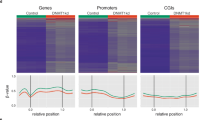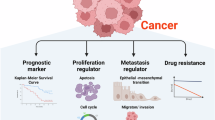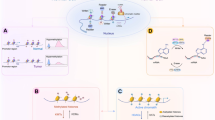Abstract
The discovery of numerous hypermethylated promoters of tumour–suppressor genes, along with a better understanding of gene–silencing mechanisms, has moved DNA methylation from obscurity to recognition as an alternative mechanism of tumour–suppressor inactivation in cancer. Epigenetic events can also facilitate genetic damage, as illustrated by the increased mutagenicity of 5–methylcytosine and the silencing of the MLH1 mismatch repair gene by DNA methylation in colorectal tumours. We review here current mechanistic understanding of the role of DNA methylation in malignant transformation, and suggest Knudson's two–hit hypothesis should now be expanded to include epigenetic mechanisms of gene inactivation.
This is a preview of subscription content, access via your institution
Access options
Subscribe to this journal
Receive 12 print issues and online access
$209.00 per year
only $17.42 per issue
Buy this article
- Purchase on SpringerLink
- Instant access to full article PDF
Prices may be subject to local taxes which are calculated during checkout


Similar content being viewed by others
References
Yang, A.S., Jones, P.A. & Shibata, A. The mutational burden of 5–methylcytosine. in Epigenetic Mechanisms of Gene Regulation (eds Riggs, A.D., Martienssen, R.A., and Russo, V.E.A.) 77–94 (Cold Spring Harbor Laboratory Press, Cold Spring Harbour, 1996).
Razin, A. & Cedar, H. DNA methylation and gene expression. Microbiol. Rev. 55, 451– 458 (1991).
Yeivin, A. & Razin, A. Gene methylation patterns and expression. in DNA Methylation: Molecular Biology and Biological Significance (eds Jost, J.P. & Saluz, H.P.) 523–568 (Birkhauser Verlag, Basel, 1993).
Kass, S.U., Pruss, D. & Wolffe, A.P. How does DNA methylation repress transcription? Trends Genet. 13, 444–449 (1997).
Jones, P.A. The methylation paradox. Trends Genet. (in press).
Razin, A. & Riggs, A.D. DNA methylation and gene function. Science 210, 604–610 (1980).
Stoger, R. et al. Maternal–specific methylation of the imprinted mouse Igf2r locus identifies the expressed locus as carrying the imprinting signal. Cell 73, 61–71 (1993).
Larsen, F., Solheim, J. & Prydz, H. A methylated CpG island 3' in the apolipoprotein–E gene does not repress its transcription. Hum. Mol. Genet. 2, 775–780 (1993).
Barry, C., Faugeron, G. & Rossignol, J.–L. Methylation induced premeiotically in Ascobolus : coextension with DNA repeat lengths and effect on transcript elongation. Proc. Natl Acad. Sci. USA 90, 4557– 4561 (1993).
Rountree, M.R. & Selker, E.U. DNA methylation inhibits elongation but not initiation of transcription in Neurospora crassa . Genes Dev. 11, 2383– 2395 (1997).
Clark, S.J., Harrison, J. & Molloy, P.L. Sp1 binding is inhibited by (m)Cp(m)CpG methylation. Gene 195, 67–71 (1997).
Prendergast, G.C. & Ziff, E.B. Methylation–sensitive sequence–specific DNA binding by the c–Myc basic region. Science 251, 186–189 ( 1991).
Zhang, X.Y., Ehrlich, K.C., Wang, R.Y. & Ehrlich, M. Effect of site–specific DNA methylation and mutagenesis on recognition by methylated DNA–binding protein from human placenta. Nucleic Acids Res. 14, 8387–8397 (1986).
Asiedu, C.K., Scotto, L., Assoian, R.K. & Ehrlich, M. Binding of AP–1/CREB proteins and of MDBP to contiguous sites downstream of the human TGF–β 1 gene. Biochim. Biophys. Acta 1219, 55–63 (1994).
Bestor, T.H. Gene silencing. Methylation meets acetylation. Nature 393, 311–312 (1998).
Nan, X., Campoy, F.J. & Bird, A. MeCP2 is a transcriptional repressor with abundant binding sites in genomic chromatin. Cell 88, 471 –481 (1997).
Nan, X. et al. Transcriptional repression by the methyl–CpG–binding protein MeCP2 involves a histone deacetylase complex. Nature 393, 386–389 (1998).
Jones, P.L. et al. Methylated DNA and MeCP2 recruit histone deacetylase to repress transcription. Nature Genet. 19, 187– 191 (1998).
Bird, A.P. CpG–rich islands and the function of DNA methylation. Nature 321, 209–213 ( 1986).
Gardiner–Garden, M. & Frommer, M. CpG islands in vertebrate genomes. J. Mol. Biol. 196, 261 –282 (1987).
Larsen, F., Gundersen, G., Lopez, R. & Prydz, H. CpG islands as gene markers in the human genome. Genomics 13, 1095–1107 (1992).
Wutz, A. et al. Imprinted expression of the Igf2r gene depends on an intronic CpG island. Nature 389, 745– 749 (1997).
Singer–Sam, J. & Riggs, A.D. X chromosome inactivation and DNA methylation. in DNA Methylation: Molecular Biology and Biological Significance (eds Jost, J.P. & Saluz, H.P.) 358 –384 (Birkhauser Verlag, Basel, 1993 ).
Issa, J.P. et al. Methylation of the oestrogen receptor CpG island links ageing and neoplasia in human colon. Nature Genet. 7, 536–540 (1994).
Issa, J.P., Vertino, P.M., Boehm, C.D., Newsham, I.F. & Baylin, S.B. Switch from monoallelic to biallelic human IGF2 promoter methylation during aging and carcinogenesis. Proc. Natl Acad. Sci. USA 93, 11757– 11762 (1996).
Jones, P.A. et al. De novo methylation of the MyoD1 CpG island during the establishment of immortal cell lines. Proc. Natl Acad. Sci. USA 87, 6117–6121 ( 1990).
Antequera, F., Boyes, J. & Bird, A. High levels of de novo methylation and altered chromatin structure at CpG islands in cell lines. Cell 62, 503– 514 (1990).
Feinberg, A.P., Gehrke, C.W., Kuo, K.C. & Ehrlich, M. Reduced genomic 5–methylcytosine content in human colonic neoplasia. Cancer Res. 48, 1159–1161 ( 1988).
Jones, P.A. DNA methylation errors and cancer. Cancer Res. 56, 2463–2467 (1996).
Baylin, S.B., Herman, J.G., Graff, J.R., Vertino, P.M. & Issa, J.P. Alterations in DNA methylation: a fundamental aspect of neoplasia. Adv. Cancer Res. 72 , 141–196 (1998).
Okano, M., Xie, S. & Li, E. Cloning and characterization of a family of novel mammalian DNA (cytosine–5) methyltransferases. Nature Genet. 19, 219 –220 (1998).
Gonzalez–Zuleta, M. et al. Methylation of the 5´ CpG island of the p16/CDKN2 tumor suppressor gene in normal and transformed human tissues correlates with gene silencing. Cancer Res. 55, 4531– 4535 (1995).
Gonzalgo, M.L. et al. The role of DNA methylation in expression of the p19/p16 locus in human bladder cancer cell lines. Cancer Res. 58, 1245–1252 (1998).
Ohtani–Fujita, N. et al. Hypermethylation in the retinoblastoma gene is associated with unilateral, sporadic retinoblastoma. Cancer Genet. Cytogenet. 98, 43–49 ( 1997).
Prowse, A.H. et al. Somatic inactivation of the VHL gene in Von Hippel–Lindau disease tumors. Am. J. Hum. Genet. 60, 765 –771 (1997).
Herman, J.G. et al. Incidence and functional consequences of hMLH1 promoter hypermethylation in colorectal carcinoma. Proc. Natl Acad. Sci. USA 95, 6870–6875 ( 1998).
Lock, L.F., Takagi, N. & Martin, G.R. Methylation of the Hprt gene on the inactive X occurs after chromosome inactivation. Cell 48, 39–46 (1987).
Grant, M., Zuccotti, M. & Monk, M. Methylation of CpG sites of two X–linked genes coincides with X–inactivation in the female mouse embryo but not in the germ line. Nature Genet. 2, 161– 166 (1992).
Singer–Sam, J. et al. Use of a HpaII–polymerase chain reaction assay to study DNA methylation in the Pgk–1 CpG island of mouse embryos at the time of X–chromosome inactivation. Mol. Cell. Biol. 10, 4987–4989 (1990).
Norris, D.P., Brockdorff, N. & Rastan, S. Methylation status of CpG–rich islands on active and inactive mouse X chromosomes. Mamm. Genome. 1, 78–83 (1991).
Li, E., Beard, C. & Jaenisch, R. Role for DNA methylation in genomic imprinting. Nature 366, 362–365 ( 1993).
Laird, P.W. et al. Suppression of intestinal neoplasia by DNA hypomethylation. Cell 81, 197–205 (1995).
Moulton, T. et al. Epigenetic lesions at the H19 locus in Wilms' tumour patients. Nature Genet. 7, 440– 447 (1994).
Steenman, M.J. et al. Loss of imprinting of IGF2 is linked to reduced expression and abnormal methylation of H19 in Wilms' tumour. Nature Genet. 7, 433–439 ( 1994).
Ohtani–Fujita, N. et al. CpG methylation inactivates the promoter activity of the human retinoblastoma tumor–suppressor gene. Oncogene 8, 1063–1067 (1993).
Veigl, M.L. et al. Biallelic inactivation of hMLH1 by epigenetic gene silencing, a novel mechanism causing human MSI cancers. Proc. Natl Acad. Sci. USA 95, 8698–8702 (1998).
Cunningham, J.M. et al. Hypermethylation of the hMLH1 promoter in colon cancer with microsatellite instability. Cancer Res. 58, 3455–3460 (1998).
Lengauer, C., Kinzler, K.W. & Vogelstein, B. DNA methylation and genetic instability in colorectal cancer cells. Proc. Natl Acad. Sci. USA 94, 2545–2550 (1997).
Ahuja, N. et al. Association between CpG island methylation and microsatellite instability in colorectal cancer. Cancer Res. 57, 3370–3374 (1997).
Hussain, S.P. & Harris, C.C. Molecular epidemiology of human cancer: contribution of mutation spectra studies of tumor suppressor genes. Cancer Res. 58, 4023–4037 (1998).
Kamb, A. et al. A cell cycle regulator potentially involved in genesis of many tumor types. Science 264, 436– 440 (1994).
Hatada, I., Sugama, T. & Mukai, T. A new imprinted gene cloned by a methylation–sensitive genome scanning method. Nucleic Acids Res. 21, 5577–5582 (1993).
Ushijima, T. et al. Establishment of methylation–sensitive–representational difference analysis and isolation of hypo– and hypermethylated genomic fragments in mouse liver tumors. Proc. Natl Acad. Sci. USA 94, 2284–2289 (1997).
Gonzalgo, M.L. et al. Identification and characterization of differentially methylated regions of genomic DNA by methylation–sensitive arbitrarily primed PCR. Cancer Res. 57, 594–599 (1997).
Huang, T.H. et al. Identification of DNA methylation markers for human breast carcinomas using the methylation–sensitive restriction fingerprinting technique. Cancer Res. 57, 1030– 1034 (1997).
Toyota, M. et al. Identification of novel aberrantly methylated CpG islands in colorectal carcinoma. Proc. Am. Assoc. Cancer Res. 39, 95 (1998).
Frommer, M. et al. A genomic sequencing protocol that yields a positive display of 5–methylcytosine residues in individual DNA strands. Proc. Natl Acad. Sci. USA 89, 1827– 1831 (1992).
Rein, T., DePamphilis, M.L. & Zorbas, H. Identifying 5–methylcytosine and related modifications in DNA genomes. Nucleic Acids Res. 26, 2255 –2264 (1998).
Gonzalgo, M.L. et al. Low frequency of p16/CDKN2A methylation in sporadic melanoma: comparative approaches for methylation analysis of primary tumors. Cancer Res. 57, 5336–5347 (1997).
Herman, J.G., Graff, J.R., Myohanen, S., Nelkin, B.D. & Baylin, S.B. Methylation–specific PCR: a novel PCR assay for methylation status of CpG islands. Proc. Natl Acad. Sci. USA 93, 9821–9826 (1996).
Gonzalgo, M.L. & Jones, P.A. Rapid quantitation of methylation differences at specific sites using methylation–sensitive single nucleotide primer extension (Ms–SNuPE). Nucleic Acids Res. 25, 2529–2531 ( 1997).
Xiong, Z. & Laird, P.W. COBRA: a sensitive and quantitative DNA methylation assay. Nucleic Acids Res. 25, 2532–2534 (1997).
Bender, C.M., Pao, M.M. & Jones, P.A. Inhibition of DNA methylation by 5–aza–2´–deoxycytidine suppresses the growth of human tumor cell lines. Cancer Res. 58, 95–101 (1998).
Lübbert, M. et al. Cytogenic response to low–dose 5–aza–2´–deoxycytidine (DAC) in poor–risk myelodysplastic syndromes (MDS)—phase II study results. Blood 90 (suppl. 1), 582a (1997).
Silverman, L.R. et al. A randomized controlled trial of subcutaneous azacytidine (aza C) in patients with the myelodysplastic syndrome (MDS): a study of the cancer and leukemia group (CALGB). Proc. ASCO 17, 14a (1998).
Jackson–Grusby, L., Laird, P.W., Magge, S.N., Moeller, B.J. & Jaenisch, R. Mutagenicity of 5–aza–2´–deoxycytidine is mediated by the mammalian DNA methyltransferase. Proc. Natl Acad. Sci. USA 94, 4681–4685 (1997).
Ramchandani, S., MacLeod, A.R., Pinard, M., von Hofe, E. & Szyf, M. Inhibition of tumorigenesis by a cytosine–DNA, methyltransferase, antisense oligodeoxynucleotide. Proc. Natl Acad. Sci. USA 94, 684–689 ( 1997).
Sakai, T. et al. Allele–specific hypermethylation of the retinoblastoma tumor–suppressor gene. Am. J. Hum. Genet. 48, 880–888 (1991).
Greenblatt, M.S., Bennett, W.P., Hollstein, M. & Harris, C.C. Mutations in the p53 tumor suppressor gene: clues to cancer etiology and molecular pathogenesis. Cancer Res. 54, 4855–4878 (1994).
Myohanen, S.K., Baylin, S.B. & Herman, J.G. Hypermethylation can selectively silence individual p16ink4A alleles in neoplasia. Cancer Res. 58, 591–593 (1998).
Yeager, T.R. et al. Overcoming cellular senescence in human cancer pathogenesis. Genes Dev. 12, 163–174 (1998).
Flores, J.F. et al. Analysis of the CDKN2A, CDKN2B and CDK4 genes in 48 Australian melanoma kindreds. Oncogene 15, 2999–3005 (1997).
Batova, A. et al. Frequent and selective methylation of p15 and deletion of both p15 and p16 in T–cell acute lymphoblastic leukemia. Cancer Res. 57, 832–836 (1997).
Hiltunen, M.O. et al. Hypermethylation of the APC (adenomatous polyposis coli) gene promoter region in human colorectal carcinoma. Int. J. Cancer 70, 644–648 ( 1997).
Acknowledgements
This work was supported by NIH/NCI grants R35 CA 49758 (P.A.J.) and R01 CA 75090 (P.W.L.)
Author information
Authors and Affiliations
Rights and permissions
About this article
Cite this article
Jones, P., Laird, P. Cancer-epigenetics comes of age. Nat Genet 21, 163–167 (1999). https://doi.org/10.1038/5947
Received:
Accepted:
Issue Date:
DOI: https://doi.org/10.1038/5947



